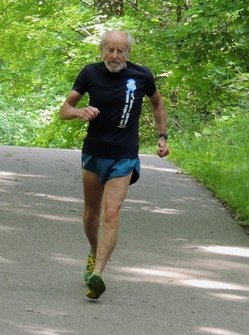 Mike, still running at 95
Mike, still running at 95 Being in Florida now has given me a chance to reflect, especially when I find a sea shell on the beach. Seashells are like people – no two are alike. Even those from the same family show differences, though sometimes the differences are hard to see. Seashells, like people, have different colors: black, brown, white, cream, yellow, red. Some are cracked and broken; some are whole. Some are sturdy and tough; some are delicate, even fragile. Some don’t look like much on their outsides, but their insides sparkle. Just like people. On the other hand, some seashells with beautiful outsides aren’t too pretty on the insides.
Being tossed in the sand for months or years can weather the shell, making it smooth and pleasing to the touch, taking off rough edges. Hopefully, we, too, improve with age. You can drop some shells, like the thick Atlantic ark, tough guys, on the floor and they practically bounce. They have resiliency, a trait that helps keep them intact. Some people are resilient, just like the arks. Some aren’t.
I’ve also noticed a lot of people in Florida in their 60s, 70s, and 80s – either living here permanently or visiting to escape the northern winter. Without being critical – and just observant – most of these people seem decrepit. Many must use canes or walkers. Some look like they just got out of bed … except that’s it’s three in the afternoon. The other day, while observing, a thought came to me: these folks come here to die. That may sound awful, but that’s what I thought. They look fragile, hopeless, pitiful – like ships without rudders, moving with the ebbs and flows of the current. What’s their purpose in life? What do they do all day?
Then I thought about the LifeNuts gold standard, Mike Fremont, who turns 95 next month. He’s still active, engaged in environmental work, trying to make a difference in the world, and he’s still running races – anything from a 5K to a half-marathon. He’s alive and he has purpose, something he taught me long ago. He’ll compete in a major canoe race this summer – 70 miles long.
The Japanese have the longest life span – nearly 84, with the females leading at 86.8. The U.S., at number 31, has moved up a few slots, now just ahead of Cuba but over four years behind Japan. Why? As I’ve mentioned – and as Mike Fremont’s life proves, a plant-based diet and a strong purpose in life are keys to Japanese longevity. OK, they eat a little fish now and then. But they eat until they’re 80 percent full and they know when to stop. And, since there’s no word for retirement in their language, they continue to fill their days with activity, with purpose.
In America and especially in Florida, or so it appears, old age is not pretty: crumbling, deteriorating, and dependent on society, medications, hospitals, nursing homes. On the brighter side, Mike Fremont shows what a LifeNut can be at 95 – vibrant, funny, energetic, alive. I want to be like Mike when I’m 95, too. I can only hope.

 RSS Feed
RSS Feed